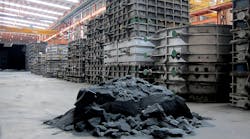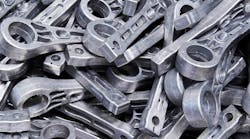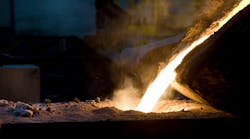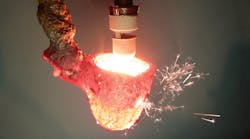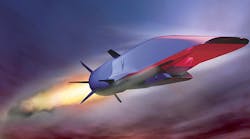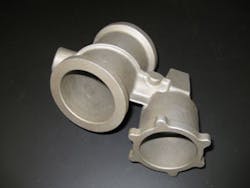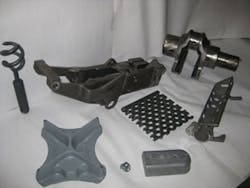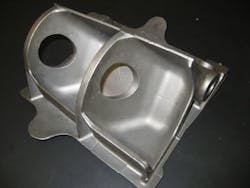Metalcasters understand that their products are important to the success of businesses and the quality of life of consumers, but one industry where castings’ contribution is especially critical is defense manufacturing.
Castings are vital to our national defense and integral to systems production and spare parts support for virtually all of the 2,250 weapon systems in service today for U.S. soldiers. The Defense Logistics Agency (DLA) — the U.S. Department of Defense's largest combat support agency — purchases more than 84% of the military’s spare parts. It supplies almost every consumable item America's military services need to operate. DLA manages 5.2 million different items, issues over 9,000 contracts per day, and had FY12 sales in excess of $44 billion. This translates to significant business opportunities for foundries, via direct business with DLA or to a tier 1 supplier.
There are very few foundries that supply the government directly because a casting is typically just the foundation of a finished part that is being procured. Most foundries manufacturing castings for defense applications do so as sub-tier suppliers, and secure the business through an existing customer or the occasional request for quote from a prospective customer.
More ambitious foundries may seek out government business opportunities on their own through various government websites and commercial bid matching services, often with limited success.
Traditional Bid Matching
For manufacturers that produce finished goods for government contracts, traditional bid matching resources are adequate to assist companies to find opportunities that align with their operations. However, for foundries that produce castings that are the basis for a finished part, the task of finding opportunities becomes much more difficult. Using typical search parameters offered by government sites, like FedBizOpps.Gov or the DLA Internet Bid Board System (DIBBS), in addition to most commercial bid matching sites, results either in too many solicitations to review or none at all.
The challenge to finding opportunities is that the search parameters used are universal and based on the finished item. Common parameters include the Federal Supply Codes (FSC), North American Industry Classification System (NAICS), Keyword, Part Number, and Commercial and Government Entity (CAGE) code. Using each one or a combination of these parameters often proves to be inefficient for metalcasters.
As an example, a search using “housing” as the keyword will return too many solicitations, while searching by a casting NAICS code such as 331524 (Aluminum Foundries) will result in very few if any results, as the NAICS codes associated with an item is predicated on the end use, not that it contains a casting.
Even using a combination of parameters often has the same outcome, which leads to frustration. Ultimately, the research gives up because the process isn't practical given the limited time and resources that most foundries have.
In addition to the search problems, if you are able to make your own system to find the right opportunities there is another difficulty with the various government procurement systems. Solicitation data can often be deficient or fragmented among different sources. A foundry looking to quote a new job not only is going to need the technical data to ensure that it has the ability to produce the part, but also needs to review it from a business standpoint to determine if it is going to be profitable. Unfortunately, the commercial terms and technical information are not coordinated, so it requires some legwork to put the pieces together to complete the review process. Common issues like unavailable drawings or procurement history may result in another dead end.
Government Procurement
As you may imagine, each of these challenges has a direct impact on the Department of Defense's (DoD) part-acquisition process to support weapon-system readiness. Every unfilled order costs the government additional time and money to establish a supply chain, to get the part manufactured and delivered, to get the weapon system waiting on that part back in service.
Another common problem is defense contractors submitting manufacturing waivers, seeking clearance to machine a part, claiming that there are no viable casting sources available. Again, this adds excessive cost and lead-time for the government.
While there are certainly many good defense contractors and casting suppliers serving the defense industry, the challenges that the government faces with procuring cast products is too significant to ignore. In fact, in its current guidance document DLA sets a priority on procurement system and process improvements implementation, along with better strategic sourcing.
NFFS’s solution is the ICON program.
The Non-Ferrous Foundes’ Society has experience building resources to link capable metalcasting suppliers to the DoD's part acquisition needs. One of the most successful (and award winning) programs in recent years that NFFS developed through the American Metalcasting Consortium (AMC) has been the Procurement Solutions Network for Castings. This web-based resource was created to simplify the procurement process for cast parts by developing a tooling database that catalogs the location of existing defense-related patterns; a casting supplier database of those foundries that manufacture parts for the defense industry, and a solicitation review process to quickly identify government procurements for cast components, and direct them to capable metalcasting facilities.
The initial process of monitoring these solicitations had to be done manually using a confirmed casting part list, determine if tooling existed, and directing solicitations to capable casting suppliers, leveraging the defense tooling database and the casting supplier database. To date, the program has generated hundreds of new business orders for foundries, and has documented millions of dollars in cost savings for the government.
Maximizing Value and Longevity
To maximize this program’s value and longevity, a new effort is underway to implement enhancements and automation to increase efficiency and improve the quality of industry response. It is called the Integrated Casting Order Network (ICON).
ICON is a web-based portal that consolidates the defense-tooling database, casting supplier database, and the bid review process. The portal integrates these components to disseminate solicitations containing castings to the appropriate casting suppliers. Furthermore, the portal provides participating metalcasters the ability to match solicitations more accurately to their companies by applying filters that will include (but will not be limited to) quantity and dollar minimum values, date of last purchase, casting size, and contract requirements.
To achieve this, NFFS has selected Lamlinks Corporation, a certified DoD value-added network (VAN) with extensive expertise in government procurement systems, to design and implement a web-based portal that provides foundries the means and flexibility to establish government business profiles, and to manage key aspects of their government business opportunities with the ability to receive active solicitation notices matched to their unique requirements.
The beta version of ICON is scheduled for release in July 2013.
The ICON system will operate from a master database of more than 20,000 cast parts, including those that have traceability of tooling as well as those that do not. NFFS is responsible for ensuring that the part information is standardized to classify material, process, manufacturing requirements, specifications, and other filter parameters defined by the industry project team. In one portal, a foundry will be able to receive business opportunities, retrieve drawings, and manage their bid activity both to government and to their customers.
In addition, the portal will become a comprehensive resource for government buyers and defense contractors to locate and submit quotations to capable metalcasting suppliers.
Unique Search/Sort
Foundries using ICON can expect better results than other bid-matching and government procurement sites deliver, thanks to ICON's unique model. For example, an aluminum sand casting foundry reviewing prospective project will discover that in the initial filter process, the portal sorts solicitations by material and process, so that it will automatically deliver only those solicitations for aluminum castings and those that can be produced using a sand mold process.
In addition, ICON verifies that technical data (drawings) is available for any solicitation prior to delivery; otherwise the solicitation is excluded from the results page. This saves the user time by eliminating the scenario of finding the right opportunity but not having the drawings available in order to quote.
So, once the aluminum foundry has a list of solicitations with technical data matched to its capabilities, the next benefit of ICON is the solicitation index page. As noted, a foundry typically evaluates solicitations on commercial and technical terms. The solicitation index assembles all of the pertinent information form evaluating the commercial advantages of submitting a quote. For each solicitation, the index provides the quantity, estimated contract dollar value, date of last buy, material, process, solicitation status (updated daily), and even a two-year forecasted demand for a particular part. All of these details are assembled so that the foundry can determine its best opportunities in a matter of seconds.
Finally, after the foundry has selected the items from the index page, the last step is to review the solicitation detail page, which contains an item's complete procurement history, recent solicitations, technical description and notes, procurement data, and a direct interface to all of the drawings and standards associated with the item. Rather than logging in to an external site to download and retrieve drawings, often in multiple file formats, ICON has a built-in interface to the government's technical data repository, so that a user can select any or all of the technical documents, and download them for review. Best of all, the system automatically converts all of the documents selected into a single .pdf document.
The result is that foundries benefit by having a resource that delivers qualified business opportunities with all of the pertinent information available. The government ultimately benefits when cast parts are directed to capable and responsive casting suppliers.
Ryan J. Moore, CAE, is the membership director for the Non-Ferrous Founders' Society. For more information on how your foundry may benefit from the ICON program, contact him at Tel. 847-299-0550, or [email protected], to discuss the ICON program.

